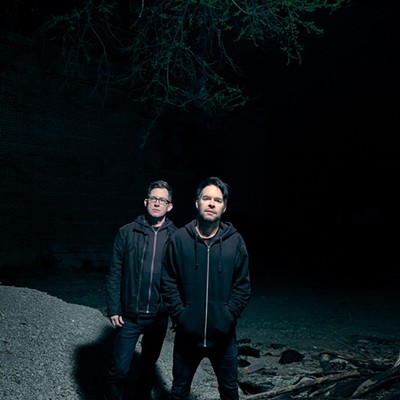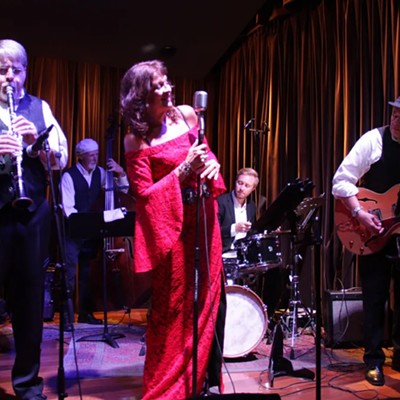Sylvie Simmons and Howe Gelb are of two minds on the subject of their initial meeting. There's the one they both are certain happened, in London in the early '80s, when Sylvie interviewed Gelb about his Tucson combo Giant Sand for The Guardian, and then there's the other one, a run-in shrouded in rock & roll mythology and obscured by the clouds of memory.
"Howe seems to think we met in 1975 ...backstage at a concert Queen was playing with Mott the Hoople," Simmons laughs over the phone, her English accent betraying her roots overseas, though she now resides in San Francisco. "According to him I had eyes on Brian May—it might have been Roger Taylor—but he seems to recall it was Brian May."
Gelb admits that "the memory blurs itself, and it reanimates the particles of the details," but he seems to recall bumping into Simmons, spilling a soda all over her white dress, ruining her "designs to flirt with the band," Gelb says chuckling.
"She looked at me—I was about Cameron Crowe's age in Almost Famous -- and she looked at me [as if] vowing that if I ever picked up a guitar, she was going to give me the most horrible review."
The scathing review never came. Instead, Simmons raved about Giant Sand, and the two would become fast friends, staying in contact as Simmons established herself as a prominent music journalist. The subject of The Rock Chick, a BBC documentary chronicling her status as a woman in a field dominated by men, Simmons has written for Mojo, Rolling Stone, and dozens of other publications; penned liner notes for albums by Emmylou Harris, The Gun Club, and Johnny Cash (her 2003 interview with Cash, included in the box set Unearthed, was one of the last interviews the country singer would give), and authored books, including a tome on French pop star Serge Gainsbourg, A Fistful of Gitanes, Too Weird for Ziggy, a collection of short stories, and I'm Your Man: The Life of Leonard Cohen, called "a new gold standard in Cohen bios" by the Los Angeles Times in 2012.
All the while, Simmons' quietly and privately composed her own songs, and eventually she began emailing them to Gelb. At his insistence, Simmons came to Tucson's Wavelab Studios to record them live to tape, and the result of those sessions is Sylvie, Simmons' debut album after more than four decades writing about music while performing it in secret. Backed by Gelb, Giant Sand's Thøger Lund, Kate Maki, Matt Wilkinson, and featuring sonic textures by engineer Chris Shultz, the album is a lilting, spooky gem.
Simmons' voice is pitched high and evocative, compared by folk singer Devendra Banhart to Rosalie Sorrels in the album's biographical materials, and Gelb's production is spare and open, drawing on the minimalism of his beloved desert landscapes. It's a rare current release by Seattle/Los Angeles-based label Light in the Attic, best known for lavish reissues by Sixto Rodriguez (of Searching for Sugar Man fame), Lee Hazlewood, Betty Davis, and Lewis.
Simmons laughs while detailing her trepidation about recording live, straight to tape, calling the process "scary as hell, because you can't correct anything on that," but loved spending time in Tucson, swimming in her hotel pool and jogging along the freeway. The process of immersing herself in her own songs was a new one for Simmons. She'd performed in her past playing guitar in a band as a teenager but abandoned the stage upon recognition that performing was "most terrifying thing in the universe." She figured instead, "I'm gonna write, and I'm gonna write about music."
Simmons is quick to acknowledge her unique position as a music journalist crossing over into the music business, and she was surprised when Light in the Attic's Matt Sullivan offered her a recoding contract. "It's difficult as a music journalist to come out with an album," she says, especially one, "slightly older than Lady Gaga, not as old as Patti Smith." But the songs speak for themselves, even if Simmons' wasn't always eager to speak for them.
"I did this interview with Eno, and we were talking about songwriting—I never mentioned that I did this in my spare time," Simmons says. "He said to me, 'You should never write a song in a minor key,' and I sort of stomped by foot and said, 'I love minor keys,' and he said, 'They're lazy. That's such an easy way to express sadness. A truly artistic way to express sadness would be to write in a major key.'"
Simmons realized that her songs were mostly in a minor key, like those of Leonard Cohen. "There's more minors thrown in there than the average English bar," Simmons laughs, saying she quickly disregarded Eno's unintentional advice.
Sylvie is indeed a sad album, with devastating couplets like, "I stopped believing in tomorrows/And yesterdays can only fade and die," and "Too many miles on my heart/Doesn't need taking for another ride," sprawled across its songs, but it's playful too, with cheeky songs like "Midnight Cowboy" and the tender "You Are In My Arms," where Simmons promises, "The tears in my eyes aren't for sorrow they're for joy/Cause you are in my arms."
"I love the fact that she's taken the long way around," Gelb says. "She's spent 40 years writing about music, but really, all along, she was just taking the long way to recording her own album." Gelb cites her writing in I'm Your Man, detailing the way certain songs would like Cohen years to finish. He likens her method to that of a detective, slowly piecing together the right elements until the case is closed. "[With] her detective mind, she can gauge [what's] important in the details," Gelb says.
That approach unites her writing and her songs, a careful attention to where each syllable falls, the precise moment when a chord on her ukulele becomes something strange and unexpected.
"What happens with ukuleles, unlike guitars, is that they're such modest little instruments, that you'll be playing and a finger will land in the wrong place, and you've invented a chord," Simmons says. "You think my God, 'I'm going to write a whole song around that.' You'll think it's your thing until some boring man tells you it's a C-9-suspended-4 plus 3 or something. But you know in your heart that you've invented this beautiful little thing, that would never have happened on a guitar, because a guitar has a certain dignity and resonance that puts you in your place, whereas a uke is more of an encourager."
Gelb too, served as an ending reserve of support for Simmons, who giggles while talking about his illustrious reputation in the U.K. "The man is absolutely unique and wonderful, and I'm so happy he wanted to work with me," she laughs. Gelb says the admiration is deeply mutual, and in true Gelb fashion, he's not above contributing their partnership to destiny.
"I was remarking [to Simmons] the time I had dinner with Bob Dylan at Poca Cosa," Gelb says. Despite his many run-ins with characters like Emmylou Harris, Billy Gibbons, Robert Plant, and other rock royalty, Gelb couldn't find the nerve to speak with Dylan. "I couldn't even ask for a hello. And it bothered me of course for a long time. "There's no one to lament this sort of thing to except someone like Sylvie," Gelb laughs.
He shared this story while watching the 2007 film I'm Not There, in which a host of actors, including Cate Blanchett, Gelb's favorite, portray various versions of Dylan.
"Sylvie released me from my lament," Gelb explains. "She said Dylan and Cate were shapeshifters, and she said it with the authority of someone who can say something like that and you don't question it." The recognition of a shared respect for mythology and mystery, perhaps dating back to their mystical meeting backstage of the Queen/Mott the Hoople double bill, was a relief to Gelb.
"I've since met other shapshifters and now I recognize them," Gelb says. "Sylvie knew that because she is one."










